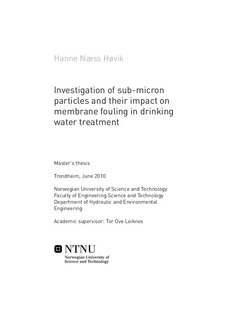| dc.description.abstract | The drinking water industry is gaining more interest in substituting conventional separation technologies for treatment of surface waters with membranes due to their separation capabilities. Low pressure membranes are particularly suitable for the removal of suspended solids, especially bacteria, algae, and protozoa namely Giardia and Cryptosporidium. However, they are less effective in removing dissolved contaminants, such as natural organic matter (NOM), which also is claimed to be the major cause of the TMP increase experienced during filtration of surface water.
The purpose of the study is to gain a better understanding of the impact of NOM on membrane fouling in low pressure submerged membrane configurations.
Constructed raw water was used in a series of filtration experiments of three different types of low pressure membranes -hydrophilic cellulose esters (MF) and two hydrophobic PVDF membranes (UF). The raw water was made by mixing NOM concentrate into tap water to represent typical Norwegian surface water. The filtration unit was operated under various conditions in order to evaluate their effect on the fouling behaviour. This included the effect of flux variations and different membrane characteristics and, the effect of pre-treatment of the raw water.
Samples of raw water, membrane permeate, and desorbed NOM from fouled membranes were collected and subjected to analysis. NOM fractionation was conducted to distinguish four different NOM fractions, i.e. very hydrophobic acids (VHA), transphilic acids/ slightly hydrophobic acids (SHA), hydrophilic charged (CHA) and hydrophilic neutrals (NEU). Analyses of colour, UV254 -absorbance and zeta potential were also applied.
The study revealed some interesting results:
Higher flux increased the fouling rate and the fouling by NEU. This was claimed to be a consequence of a more severe concentration polarization and gel layer formation.Hydrophobic-hydrophilic interactions seemed to be the dominating mechanism in NOM-membrane interaction.The main foulant were attributed the VHA in all filtration experiments except for the MF experiment operated at highest flux were the NEUs were dominating.Pre-treatment reduced the rate of fouling tremendously, indicating that the pretreatmentwere efficient in removing some of the NOM fractions responsible for the fouling.
In summary, strategies to reduce fouling may include careful membrane selection and pretreatment of the raw water. Sufficient knowledge about the composition of raw water is also important. | nb_NO |
